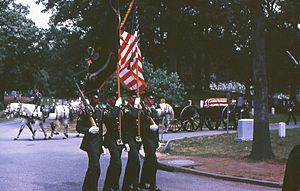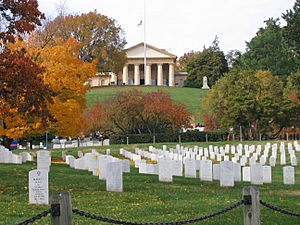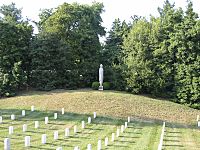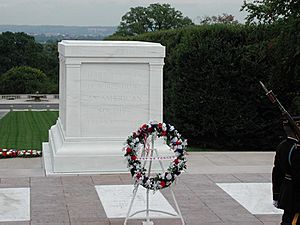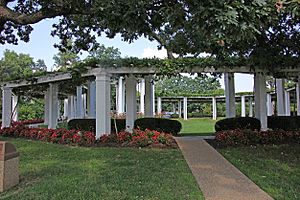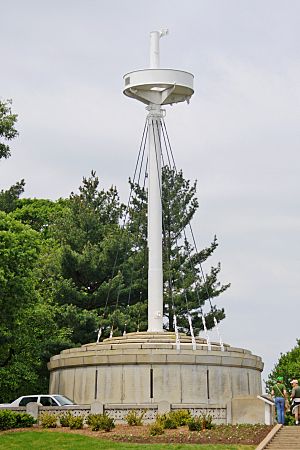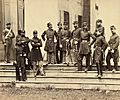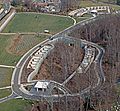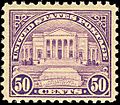Arlington National Cemetery facts for kids
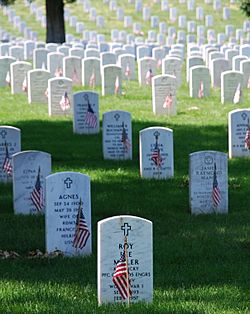
The gravestones at Arlington National Cemetery are marked by U.S. flags each Memorial Day.
|
|
| Details | |
|---|---|
| Established | June 28, 1864 |
| Location | |
| Country | United States |
| Type | Public |
| Owned by | United States Department of the Army |
| Size | 624 acres (2.5 km2) |
| No. of graves | 300,000 |
Arlington National Cemetery is a special cemetery in Arlington County, Virginia. It is where many people who served in the United States military are buried. This important place started during the American Civil War. It is built on a large farm that used to be called Arlington House.
Arlington House was once the home of Mary Anna Custis Lee. She was a great-granddaughter of Martha Washington and the wife of Confederate general Robert E. Lee. Even though most of the land is now covered with graves, the old farmhouse still stands in the middle. The cemetery is located across the Potomac River from the Lincoln Memorial in Washington, D.C..
The cemetery is very large, covering about 624 acres (2.53 km2). People who died serving the United States in wars, and military veterans, can be buried here. This includes those who fought in wars from the American Civil War to more recent actions in Afghanistan and Iraq. Any people buried here before the Civil War were moved and reburied after the year 1900.
The United States Army takes care of Arlington National Cemetery. However, Arlington House and its land are looked after by the National Park Service. This is done to remember Robert E. Lee.
Contents
History of Arlington National Cemetery
How Arlington Became a Cemetery
George Washington Parke Custis was the grandson of Martha Washington. He grew up with Martha and George Washington. In 1802, he received the land that is now Arlington National Cemetery. He started building Arlington House there. He lived in the house with his wife, Mary Lee Fitzhugh Custis.
The land and house were later given to their only child who lived to be an adult, Mary Anna Custis Lee. She was married to Robert E. Lee. He was a graduate of West Point and an officer in the United States Army.
When the American Civil War began, President Abraham Lincoln asked Lee to lead the federal army. Lee waited to see if his home state of Virginia would leave the Union. When Virginia decided to leave the United States, Lee left the federal army. He felt he could not fight against his home state. He became a leader of the armed forces for the Commonwealth of Virginia. Then, he became the commander of the Army of Northern Virginia.
Many Union officers felt Lee had broken his promises by fighting against them. So, part of Arlington was taken from the Lee family. It was turned into a graveyard. Most of the soldiers buried there were from the Union army.
Before the Civil War, the United States did not have many large military cemeteries. Important generals were often buried in places like the Congressional Cemetery. But during the Civil War, many soldiers died. New burial grounds were needed near Washington, D.C. In 1864, Quartermaster General Montgomery C. Meigs suggested using about 200 acres (81 hectares) of the Robert E. Lee family property at Arlington for a cemetery.
The Land Sale and Return
During the Civil War, the government made rules to make things difficult for those fighting against the Union. One rule was that property owners had to pay taxes in person. If they did not, the government could sell their land. The government bought Arlington at a tax sale in 1864 for $26,800. Mrs. Lee had sent someone to pay the $92.07 in property taxes. But the government refused to accept the payment from her agent.
In 1874, Custis Lee, Mary Anna Custis Lee's son, sued the United States. He claimed he owned Arlington. The U.S. Supreme Court decided that Arlington had been taken illegally. So, Congress gave the land back to him. The next year, Custis Lee sold it back to the government for $150,000.
Recent Events
In 2011, Hurricane Irene caused six large trees to fall at the cemetery. The "Arlington Oak," which was 220 years old, fell near the grave of John F. Kennedy.
Sections of the Cemetery
Arlington National Cemetery is divided into 70 areas, called sections. Some sections in the southeast are saved for future use. Section 60 is where many military members killed in the Iraq War and the War in Afghanistan are buried.
In 2005, Arlington National Cemetery bought more land. They added about 12 acres (4.9 hectares) from the National Park Service. They also added 17 acres (6.9 hectares) from the Department of Defense and 44 acres (18 hectares) from the Navy Annex.
Section 21 is known as the Nurses Section. Many nurses are buried there, and it has the Nurses Memorial. There is also a Confederate section for soldiers of the Confederate States of America. Their headstones are peaked, not rounded. In Section 27, more than 3,800 former slaves, called "Contrabands" during the Civil War, are buried. Their headstones say "Civilian" or "Citizen."
Grave Markers and Headstones
The United States Department of Veterans Affairs helps families choose words and religious symbols for headstones. They do this for free. There are 39 approved symbols to show a person's faith.
Before 2001, people could buy their own special markers in some areas. These older sections have many different private markers. Some even include old artillery pieces.
Tomb of the Unknowns
The Tomb of the Unknowns is also called the "Tomb of the Unknown Soldier". It sits on a hill looking over Washington, D.C. This tomb honors soldiers who died but could not be identified.
The Tomb is one of the most visited spots at the Cemetery. It is made from Yule marble from Colorado. It has seven large pieces and weighs about 79 short tons (72 metric tons). The tomb was finished and opened to the public on April 9, 1932. It cost $48,000 to build.
U.S. Army guards have stood watch at the Tomb of the Unknowns all the time since July 2, 1937. The 3rd U.S. Infantry Regiment ("The Old Guard") started guarding the Tomb on April 6, 1948.
Arlington Memorial Amphitheater
The Tomb of the Unknowns is part of the Arlington Memorial Amphitheater. This amphitheater is used for important ceremonies. These include state funerals and events for Memorial Day and Veterans Day. Ceremonies are also held for Easter. About 5,000 people attend these holiday events each year.
The building is mostly made of Imperial Danby marble from Vermont. The Memorial Display room, between the amphitheater and the Tomb, uses Botticino stone from Italy. The amphitheater was built because Ivory Kimball wanted a place to honor America's soldiers. Congress approved the building on March 4, 1913. Woodrow Wilson placed the first stone for the building on October 15, 1915. This stone held 15 items, including a Bible and a copy of the Constitution.
Netherlands Carillon
The Netherlands Carillon is a carillon (bell tower). It was a gift from the Netherlands to the United States in 1954. It was given to thank the U.S. for its help during World War II. People with special training play the bells regularly in the summer and on special days. Recorded tunes play every hour and throughout the day. It is located next to Arlington National Cemetery, on the north side.
Memorials at Arlington

It is becoming difficult to find space for new memorials at the cemetery. The army is concerned that new memorials take up space that could be used for graves. The army now requires a special approval from Congress before new memorials can be placed. Still, there are several memorials already there, and groups often ask for space for new ones.
The Space Shuttle Challenger Memorial was dedicated on May 20, 1986. It remembers the crew of flight STS-51-L. They died during launch on January 28, 1986. The back of the stone has words from the poem High Flight. Some remains of the crew were not identified. They were laid to rest under this marker. Two crew members, Scobee and Smith, are also buried in Arlington.
There is a similar memorial for those who died when the Shuttle Columbia broke apart during reentry on February 1, 2003. It was dedicated one year after the accident. Astronauts Laurel Clark, David Brown, and Michael Anderson are also buried in Arlington.
The Cairn, the Lockerbie memorial, remembers the 270 people killed in the bombing of Pan Am Flight 103. This happened over Lockerbie, Scotland. The memorial has 270 stones, one for each person who died. In section 64, there is a memorial for the 184 victims of the September 11 attacks on the Pentagon. This memorial is shaped like a pentagon and lists all the victims' names.
There are only two mausoleums (large tomb buildings) in the cemetery. One is for the family of General Nelson Appleton Miles. The other belongs to the family of General Thomas Crook Sullivan.
There is a Commonwealth Cross of Sacrifice. It lists the names of U.S. citizens who died fighting in Canadian forces. This includes those from the Korean War and both World Wars.
The Women in Military Service for America Memorial is at the main entrance to Arlington National Cemetery.
Notable Burials
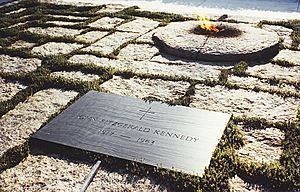
The first soldier buried in Arlington was Private William Henry Christman from Pennsylvania. He was buried on May 13, 1864.
Famous Civilians Buried at Arlington
- Julian Bartley, Sr. and his son Jay Bartley, killed in the 1998 United States embassy bombings in Nairobi.
- Harry Blackmun, Thurgood Marshall, William O. Douglas, and Potter Stewart, four justices of the Supreme Court of the United States.
- Leslie Coffelt, a Secret Service member. He died fighting attackers trying to harm President Harry S. Truman in 1950.
- George Washington Parke Custis, who started Arlington Plantation. He was Martha Washington's grandson.
- Mary Lee Fitzhugh Custis, wife of George Washington Parke Custis.
- Albert Sabin, a scientist who helped create a polio vaccine.
- Charles Durning, a well-known actor.
- Jacqueline Kennedy Onassis, former First Lady and wife of John F. Kennedy.
- Phyllis Kirk, a famous TV and movie actress.
- James Parks, a freedman. He is the only person buried at Arlington Cemetery who was born on the grounds.
- Mary Randolph, the first person buried at Arlington Plantation.
- Marie Teresa Rios, author of Fifteenth Pelican.
- John Gibson and Jacob Chestnut, United States Capitol Police officers killed in the 1998 Capitol shooting.
- Leslie Sherman, a student killed in the 2007 Virginia Tech massacre.
- Martin D. Ginsburg, law professor and husband of Ruth Bader Ginsburg.
- Ruth Bader Ginsburg, Associate Justice of the Supreme Court of the United States.
U.S. presidents can be buried at Arlington. This is because they lead the armed forces as commanders-in-chief.
Four state funerals have been held at Arlington. These were for Presidents William Howard Taft and John F. Kennedy. Also, for General John J. Pershing and U.S. Senator Edward M. Kennedy.
Notable Military Burials
As of May 2006, 367 people who received the Medal of Honor are buried in Arlington. Nine of these were Canadians.
Many important military leaders are buried here, including:
- Creighton Abrams, a General who led U.S. military actions in the Vietnam War.
- Henry "Hap" Arnold, the first (and only) General of the Air Force (5-Stars).
- Jeremy Michael Boorda, a U.S. Navy Admiral.
- Gregory "Pappy" Boyington, a World War II Marine Corps fighter ace.
- Omar Nelson Bradley, a General who led the 12th Army Group in Europe during World War II.
- Ruby G. Bradley, a Colonel and one of the most decorated women in U.S. military history.
- Frank Buckles, the last known American veteran of World War I.
- Roger Chaffee and Gus Grissom, astronauts killed in the Apollo 1 fire.
- Claire Lee Chennault, who led the "Flying Tigers" during World War II.
- William "Wild Bill" Donovan, Chief of the OSS during World War II.
- Abner Doubleday, a Civil War general often credited with inventing baseball.
- Frank J. Fletcher, a U.S. Navy Admiral in World War II.
- Rene Gagnon, Ira Hayes, and Michael Strank, three of the six servicemen in the famous Raising the Flag on Iwo Jima picture.
- William "Bull" Halsey, a World War II Navy five-star Fleet Admiral.
- Grace Hopper, a rear admiral and a pioneer in computer science.
- Daniel "Chappie" James, Jr., the first African American four-star General in the U.S. Armed Forces.
- John S. McCain, Sr., a U.S. Navy Admiral.
- John S. McCain, Jr., a U.S. Navy Admiral and father of Senator John McCain.
- Montgomery Cunningham Meigs, the General who helped establish Arlington National Cemetery.
- Glenn Miller, a famous band leader who disappeared during World War II. He has a memorial headstone.
- Audie Murphy, the most decorated U.S. Soldier in World War II and an actor.
- John J. Pershing, America's first General of the Armies, who led American forces in World War I.
- Philip Sheridan, a commanding general in the Union Army during the Civil War.
- Walter Bedell Smith, a General in World War II and Director of the CIA.
- Matt Urban, a Colonel and one of the most decorated soldiers for bravery in U.S. military history.
- Jonathan Mayhew Wainwright IV, a Major General and hero of Bataan and Corregidor.
- Joseph Wheeler, a Major General who served in both the Confederate Army and the U.S. Army.
- Charles Young, the first African-American Lieutenant colonel in the U.S. Army.
Service Members with Other Important Careers
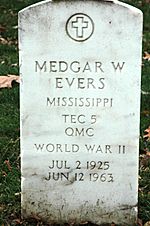
- Sosthenes Behn, founder of ITT Corporation.
- Hugo Black, Associate Justice of the Supreme Court of the United States.
- William J. Brennan, Jr., Associate Justice of the Supreme Court of the United States.
- Ron Brown, United States Secretary of Commerce.
- William Jennings Bryan, Secretary of State and three-time presidential candidate.
- Clark Clifford, Secretary of Defense and advisor to four presidents.
- Charles "Pete" Conrad, Jr., Apollo astronaut and the third person to walk on the Moon.
- Dwight F. Davis, Secretary of War who started the Davis Cup in tennis.
- Michael E. DeBakey, a famous heart surgeon and World War II soldier.
- John Foster Dulles, Secretary of State.
- Medgar Evers, a World War II veteran and important civil rights activist.
- Dashiell Hammett, a famous author.
- Oliver Wendell Holmes, Jr, Associate Justice of the Supreme Court. He was wounded three times in the Civil War.
- Robert Todd Lincoln, Secretary of War and son of President Abraham Lincoln.
- Joe Louis, a world heavyweight boxing champion.
- Mike Mansfield, the longest-serving Senate Majority Leader.
- George C. Marshall, Chief of Staff of the Army and General of the Army. He helped create the Marshall Plan after World War II.
- Lee Marvin, a Marine Corps veteran and actor.
- Bill Mauldin, a cartoonist known for his World War II work in Stars and Stripes.
- Daniel Patrick Moynihan, a U.S. Senator from New York.
- William Rehnquist, Chief Justice of the United States.
- Frank Reynolds, an ABC television anchorman.
- Johnny Micheal Spann, a CIA officer and the first American killed in Afghanistan.
- Ted Stevens, a U.S. Senator from Alaska.
- William Howard Taft, Secretary of War, President of the United States, and Chief Justice of the United States.
- George Westinghouse, a Civil War veteran and founder of Westinghouse Electric.
- Harvey W. Wiley, the first Commissioner of the Food and Drug Administration.
- William Christman, the first soldier to be buried at Arlington Cemetery.
Images for kids
-
Officers of the 8th New York State Militia at Arlington House, June 1861
-
Arlington National Cemetery and the Netherlands Carillon in December 2012
-
The Old Guard transports the flag-draped casket of the second Sergeant Major of the Army, George W. Dunaway, who was buried with full military honors at Arlington National Cemetery
-
Gravestones at the cemetery are marked by U.S. flags each Memorial Day
-
The flag at Arlington House is lowered to half-staff during interments.
-
The grave marker of former U.S. President John F. Kennedy
See also
 In Spanish: Cementerio Nacional de Arlington para niños
In Spanish: Cementerio Nacional de Arlington para niños


